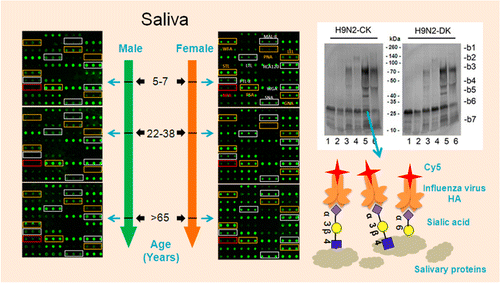Saliva proteins may protect older people from influenza

Spit. Drool. Dribble. Saliva is not normally a topic of polite conversation, but it may be the key to explaining the age and sex bias exhibited by influenza and other diseases, according to a new study. Published in ACS' Journal of Proteome Research, it provides new insights into why older people were better able to fight off the new strains of "bird" flu and "swine" flu than younger people.
Zheng Li and colleagues explain that saliva does more than start the process of digesting certain foods. Saliva also contains germ-fighting proteins that are a first-line defense against infections. Scientists already knew that levels of certain glycoproteins—proteins with a sugar coating that combat disease-causing microbes—differ with age. Li's team took a closer look at how those differences affected vulnerability to influenza.
Their tests of 180 saliva samples from men and women of various ages suggested that seniors, who fought off the bird flu better than the younger groups, might thank their saliva. Glycoproteins in saliva of people age 65 and over were more efficient in binding to influenza than those in children and young adults. The research "may provide useful information to help understand some age-related diseases and physiological phenomenon specific to women or men, and inspire new ideas for prevention and diagnosis of the diseases by considering the individual conditions based primarily on the salivary analysis," the scientists state.
More information: "Age- and Sex-Associated Differences in the Glycopatterns of Human Salivary Glycoproteins and Their Roles against Influenza A Virus" J. Proteome Res., 2013, 12 (6), pp 2742–2754 DOI: 10.1021/pr400096w
Abstract
Recent studies have elucidated that expression of certain glycoproteins in human saliva is increased or decreased according to age; meanwhile, human saliva may inhibit viral infection and prevent viral transmission. However, little is known about the age- and sex-associated differences in the glycopatterns of human salivary glycoproteins and their significant roles against influenza A virus (IVA). Here, we investigate the glycopatterns of human salivary glycoproteins with 180 healthy saliva samples divided into six age/sex groups using lectin microarrays and fabricate saliva microarrays to validate the terminal carbohydrate moieties of glycoproteins in individual saliva samples. Furthermore, we assess the inhibiting and neutralizing activity of saliva against two strains of influenza A (H9N2) virus. We find that seven lectins (e.g., MAL-II and SNA) show significant age differences in both females and males, and seven lectins (e.g., WFA and STL) show significant sex differences in children, adults and elderly people. Interestingly, we observe that elderly individuals have strongest resistance to IVA partly by presenting more terminal α2–3/6-linked sialic acid residues in their saliva, which bind with the influenza viral hemagglutinations. We conclude that age- and sex-associated differences in the glycopatterns of human salivary glycoproteins may provide pivotal information to help understand some age related diseases and physiological phenomena.
Journal information: Journal of Proteome Research
Provided by American Chemical Society

















